Factors Influencing Employee Motivation and Job Satisfaction Report
VerifiedAdded on 2022/12/06
|8
|1974
|371
Report
AI Summary
This report delves into the multifaceted reasons behind employee motivation and its profound impact on the workplace. It examines various factors, including communication, challenging work, opportunities for growth, performance recognition, a positive company culture, and employee wellbeing, highlighting their roles in fostering engagement and satisfaction. The report further analyzes the constructive and negative aspects of job roles, emphasizing the significance of job satisfaction and its correlation with employee morale, productivity, and turnover rates. It concludes by underscoring the importance of understanding and addressing these factors to enhance employee performance and overall organizational success. The report also references various studies to support its findings, providing a comprehensive overview of the subject matter.
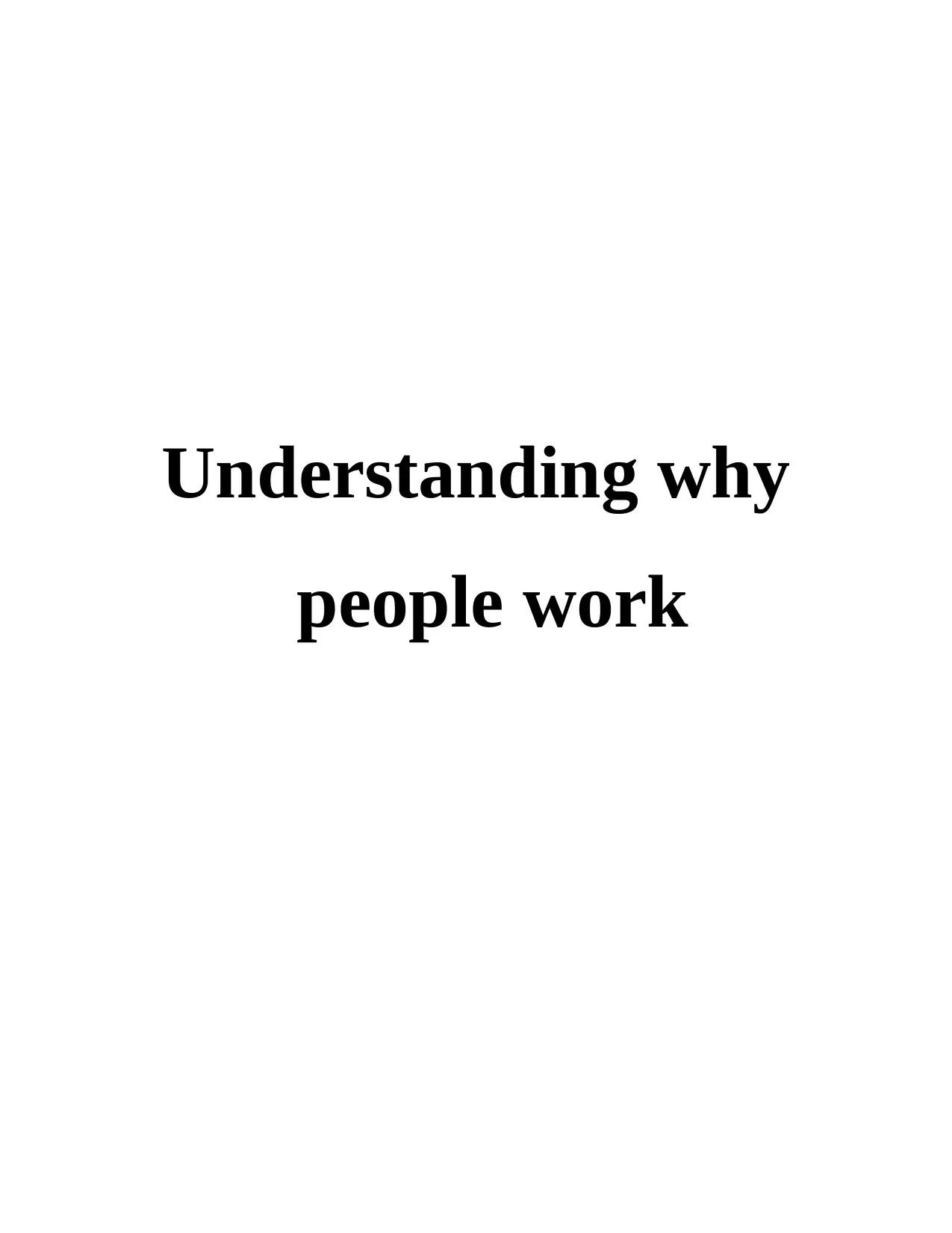
Understanding why
people work
people work
Paraphrase This Document
Need a fresh take? Get an instant paraphrase of this document with our AI Paraphraser
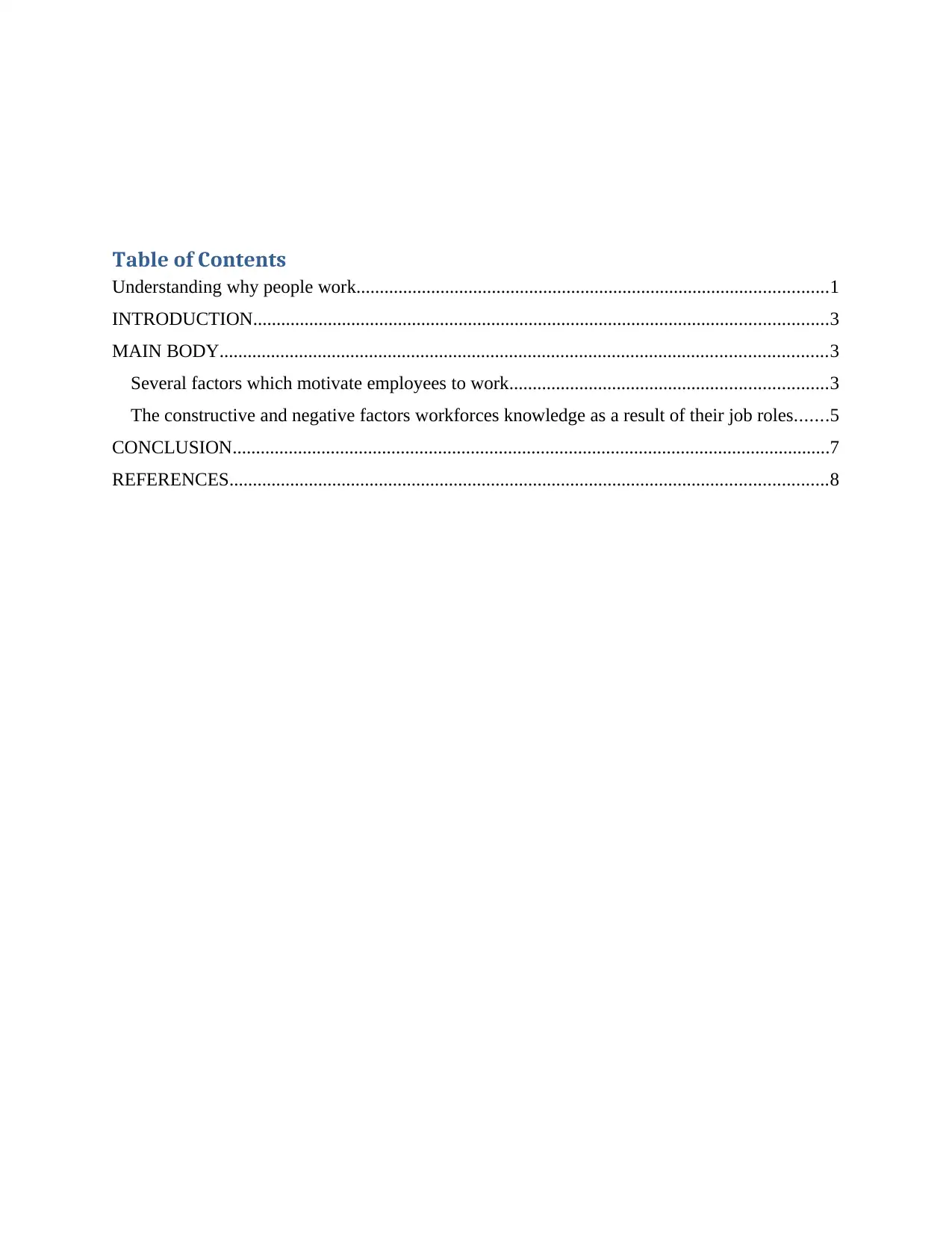
Table of Contents
Understanding why people work.....................................................................................................1
INTRODUCTION...........................................................................................................................3
MAIN BODY..................................................................................................................................3
Several factors which motivate employees to work....................................................................3
The constructive and negative factors workforces knowledge as a result of their job roles.......5
CONCLUSION................................................................................................................................7
REFERENCES................................................................................................................................8
Understanding why people work.....................................................................................................1
INTRODUCTION...........................................................................................................................3
MAIN BODY..................................................................................................................................3
Several factors which motivate employees to work....................................................................3
The constructive and negative factors workforces knowledge as a result of their job roles.......5
CONCLUSION................................................................................................................................7
REFERENCES................................................................................................................................8
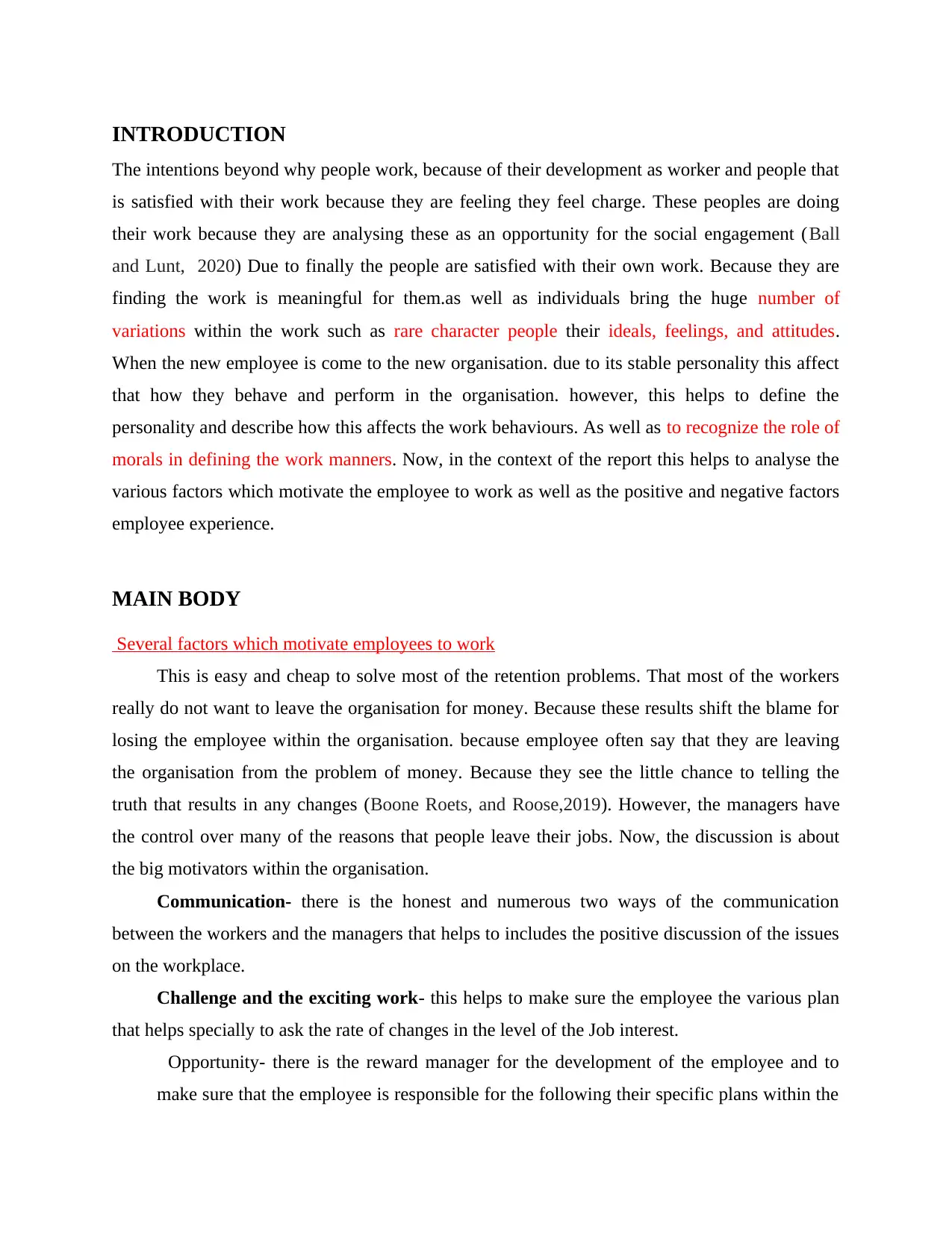
INTRODUCTION
The intentions beyond why people work, because of their development as worker and people that
is satisfied with their work because they are feeling they feel charge. These peoples are doing
their work because they are analysing these as an opportunity for the social engagement (Ball
and Lunt, 2020) Due to finally the people are satisfied with their own work. Because they are
finding the work is meaningful for them.as well as individuals bring the huge number of
variations within the work such as rare character people their ideals, feelings, and attitudes.
When the new employee is come to the new organisation. due to its stable personality this affect
that how they behave and perform in the organisation. however, this helps to define the
personality and describe how this affects the work behaviours. As well as to recognize the role of
morals in defining the work manners. Now, in the context of the report this helps to analyse the
various factors which motivate the employee to work as well as the positive and negative factors
employee experience.
MAIN BODY
Several factors which motivate employees to work
This is easy and cheap to solve most of the retention problems. That most of the workers
really do not want to leave the organisation for money. Because these results shift the blame for
losing the employee within the organisation. because employee often say that they are leaving
the organisation from the problem of money. Because they see the little chance to telling the
truth that results in any changes (Boone Roets, and Roose,2019). However, the managers have
the control over many of the reasons that people leave their jobs. Now, the discussion is about
the big motivators within the organisation.
Communication- there is the honest and numerous two ways of the communication
between the workers and the managers that helps to includes the positive discussion of the issues
on the workplace.
Challenge and the exciting work- this helps to make sure the employee the various plan
that helps specially to ask the rate of changes in the level of the Job interest.
Opportunity- there is the reward manager for the development of the employee and to
make sure that the employee is responsible for the following their specific plans within the
The intentions beyond why people work, because of their development as worker and people that
is satisfied with their work because they are feeling they feel charge. These peoples are doing
their work because they are analysing these as an opportunity for the social engagement (Ball
and Lunt, 2020) Due to finally the people are satisfied with their own work. Because they are
finding the work is meaningful for them.as well as individuals bring the huge number of
variations within the work such as rare character people their ideals, feelings, and attitudes.
When the new employee is come to the new organisation. due to its stable personality this affect
that how they behave and perform in the organisation. however, this helps to define the
personality and describe how this affects the work behaviours. As well as to recognize the role of
morals in defining the work manners. Now, in the context of the report this helps to analyse the
various factors which motivate the employee to work as well as the positive and negative factors
employee experience.
MAIN BODY
Several factors which motivate employees to work
This is easy and cheap to solve most of the retention problems. That most of the workers
really do not want to leave the organisation for money. Because these results shift the blame for
losing the employee within the organisation. because employee often say that they are leaving
the organisation from the problem of money. Because they see the little chance to telling the
truth that results in any changes (Boone Roets, and Roose,2019). However, the managers have
the control over many of the reasons that people leave their jobs. Now, the discussion is about
the big motivators within the organisation.
Communication- there is the honest and numerous two ways of the communication
between the workers and the managers that helps to includes the positive discussion of the issues
on the workplace.
Challenge and the exciting work- this helps to make sure the employee the various plan
that helps specially to ask the rate of changes in the level of the Job interest.
Opportunity- there is the reward manager for the development of the employee and to
make sure that the employee is responsible for the following their specific plans within the
⊘ This is a preview!⊘
Do you want full access?
Subscribe today to unlock all pages.

Trusted by 1+ million students worldwide
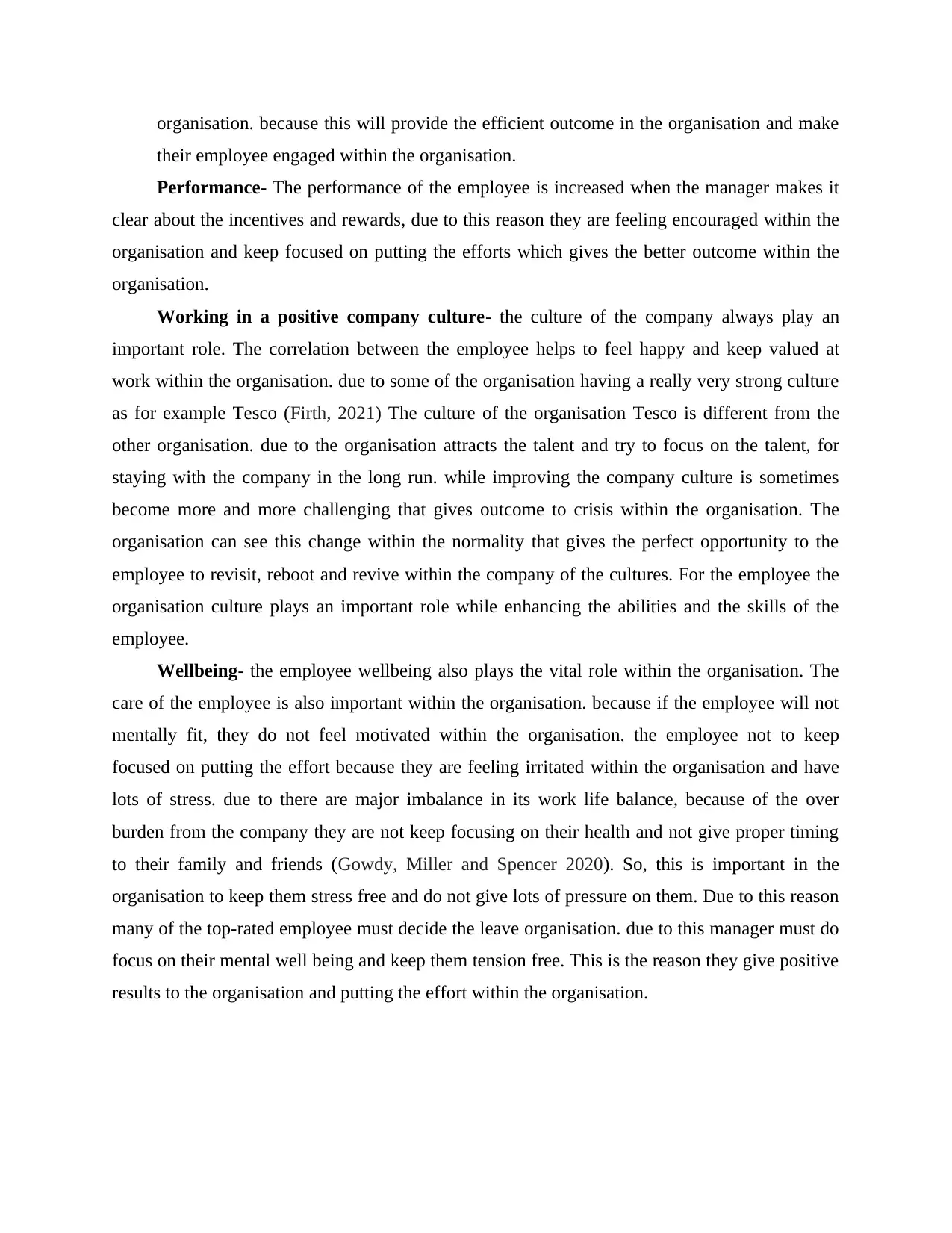
organisation. because this will provide the efficient outcome in the organisation and make
their employee engaged within the organisation.
Performance- The performance of the employee is increased when the manager makes it
clear about the incentives and rewards, due to this reason they are feeling encouraged within the
organisation and keep focused on putting the efforts which gives the better outcome within the
organisation.
Working in a positive company culture- the culture of the company always play an
important role. The correlation between the employee helps to feel happy and keep valued at
work within the organisation. due to some of the organisation having a really very strong culture
as for example Tesco (Firth, 2021) The culture of the organisation Tesco is different from the
other organisation. due to the organisation attracts the talent and try to focus on the talent, for
staying with the company in the long run. while improving the company culture is sometimes
become more and more challenging that gives outcome to crisis within the organisation. The
organisation can see this change within the normality that gives the perfect opportunity to the
employee to revisit, reboot and revive within the company of the cultures. For the employee the
organisation culture plays an important role while enhancing the abilities and the skills of the
employee.
Wellbeing- the employee wellbeing also plays the vital role within the organisation. The
care of the employee is also important within the organisation. because if the employee will not
mentally fit, they do not feel motivated within the organisation. the employee not to keep
focused on putting the effort because they are feeling irritated within the organisation and have
lots of stress. due to there are major imbalance in its work life balance, because of the over
burden from the company they are not keep focusing on their health and not give proper timing
to their family and friends (Gowdy, Miller and Spencer 2020). So, this is important in the
organisation to keep them stress free and do not give lots of pressure on them. Due to this reason
many of the top-rated employee must decide the leave organisation. due to this manager must do
focus on their mental well being and keep them tension free. This is the reason they give positive
results to the organisation and putting the effort within the organisation.
their employee engaged within the organisation.
Performance- The performance of the employee is increased when the manager makes it
clear about the incentives and rewards, due to this reason they are feeling encouraged within the
organisation and keep focused on putting the efforts which gives the better outcome within the
organisation.
Working in a positive company culture- the culture of the company always play an
important role. The correlation between the employee helps to feel happy and keep valued at
work within the organisation. due to some of the organisation having a really very strong culture
as for example Tesco (Firth, 2021) The culture of the organisation Tesco is different from the
other organisation. due to the organisation attracts the talent and try to focus on the talent, for
staying with the company in the long run. while improving the company culture is sometimes
become more and more challenging that gives outcome to crisis within the organisation. The
organisation can see this change within the normality that gives the perfect opportunity to the
employee to revisit, reboot and revive within the company of the cultures. For the employee the
organisation culture plays an important role while enhancing the abilities and the skills of the
employee.
Wellbeing- the employee wellbeing also plays the vital role within the organisation. The
care of the employee is also important within the organisation. because if the employee will not
mentally fit, they do not feel motivated within the organisation. the employee not to keep
focused on putting the effort because they are feeling irritated within the organisation and have
lots of stress. due to there are major imbalance in its work life balance, because of the over
burden from the company they are not keep focusing on their health and not give proper timing
to their family and friends (Gowdy, Miller and Spencer 2020). So, this is important in the
organisation to keep them stress free and do not give lots of pressure on them. Due to this reason
many of the top-rated employee must decide the leave organisation. due to this manager must do
focus on their mental well being and keep them tension free. This is the reason they give positive
results to the organisation and putting the effort within the organisation.
Paraphrase This Document
Need a fresh take? Get an instant paraphrase of this document with our AI Paraphraser
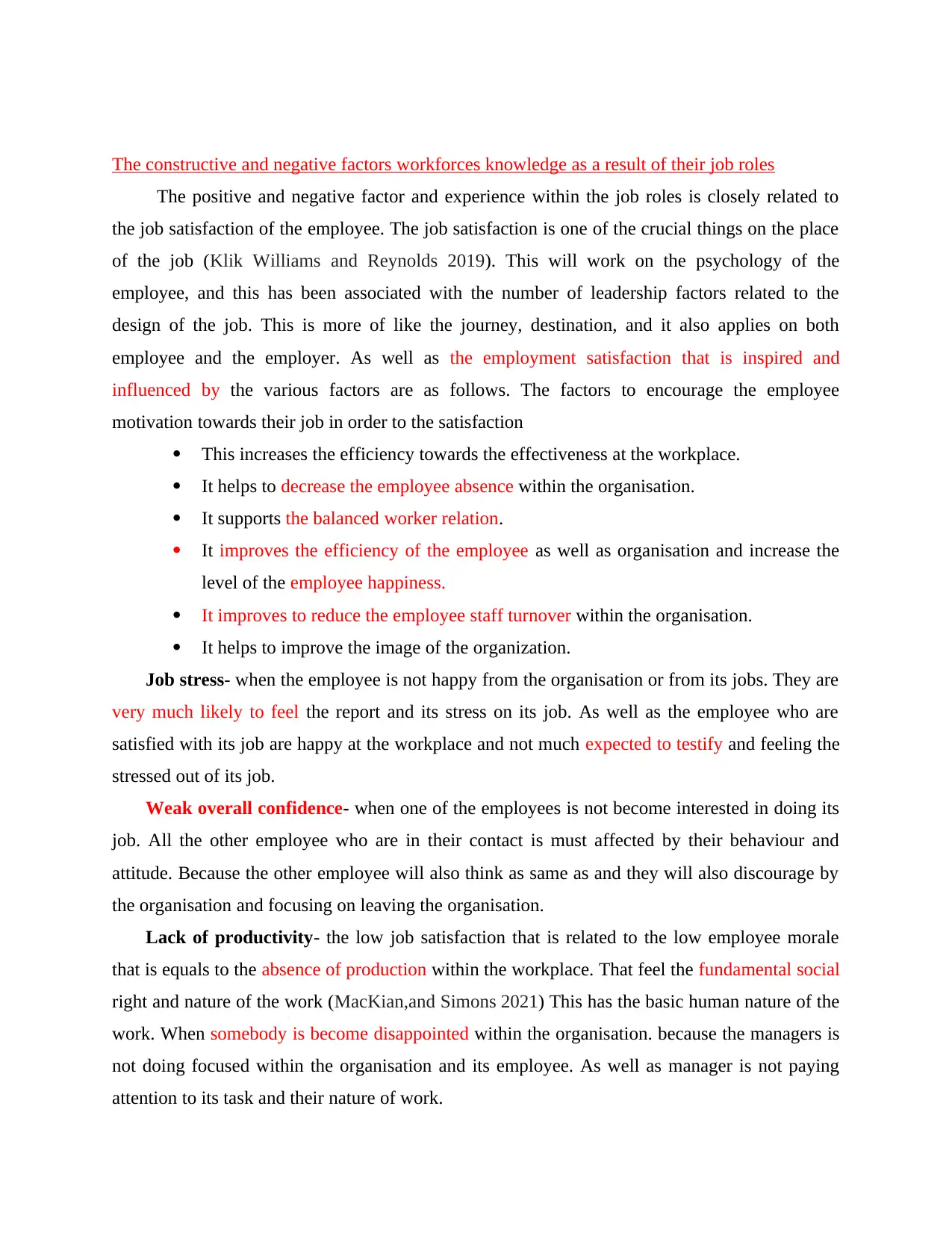
The constructive and negative factors workforces knowledge as a result of their job roles
The positive and negative factor and experience within the job roles is closely related to
the job satisfaction of the employee. The job satisfaction is one of the crucial things on the place
of the job (Klik Williams and Reynolds 2019). This will work on the psychology of the
employee, and this has been associated with the number of leadership factors related to the
design of the job. This is more of like the journey, destination, and it also applies on both
employee and the employer. As well as the employment satisfaction that is inspired and
influenced by the various factors are as follows. The factors to encourage the employee
motivation towards their job in order to the satisfaction
This increases the efficiency towards the effectiveness at the workplace.
It helps to decrease the employee absence within the organisation.
It supports the balanced worker relation.
It improves the efficiency of the employee as well as organisation and increase the
level of the employee happiness.
It improves to reduce the employee staff turnover within the organisation.
It helps to improve the image of the organization.
Job stress- when the employee is not happy from the organisation or from its jobs. They are
very much likely to feel the report and its stress on its job. As well as the employee who are
satisfied with its job are happy at the workplace and not much expected to testify and feeling the
stressed out of its job.
Weak overall confidence- when one of the employees is not become interested in doing its
job. All the other employee who are in their contact is must affected by their behaviour and
attitude. Because the other employee will also think as same as and they will also discourage by
the organisation and focusing on leaving the organisation.
Lack of productivity- the low job satisfaction that is related to the low employee morale
that is equals to the absence of production within the workplace. That feel the fundamental social
right and nature of the work (MacKian,and Simons 2021) This has the basic human nature of the
work. When somebody is become disappointed within the organisation. because the managers is
not doing focused within the organisation and its employee. As well as manager is not paying
attention to its task and their nature of work.
The positive and negative factor and experience within the job roles is closely related to
the job satisfaction of the employee. The job satisfaction is one of the crucial things on the place
of the job (Klik Williams and Reynolds 2019). This will work on the psychology of the
employee, and this has been associated with the number of leadership factors related to the
design of the job. This is more of like the journey, destination, and it also applies on both
employee and the employer. As well as the employment satisfaction that is inspired and
influenced by the various factors are as follows. The factors to encourage the employee
motivation towards their job in order to the satisfaction
This increases the efficiency towards the effectiveness at the workplace.
It helps to decrease the employee absence within the organisation.
It supports the balanced worker relation.
It improves the efficiency of the employee as well as organisation and increase the
level of the employee happiness.
It improves to reduce the employee staff turnover within the organisation.
It helps to improve the image of the organization.
Job stress- when the employee is not happy from the organisation or from its jobs. They are
very much likely to feel the report and its stress on its job. As well as the employee who are
satisfied with its job are happy at the workplace and not much expected to testify and feeling the
stressed out of its job.
Weak overall confidence- when one of the employees is not become interested in doing its
job. All the other employee who are in their contact is must affected by their behaviour and
attitude. Because the other employee will also think as same as and they will also discourage by
the organisation and focusing on leaving the organisation.
Lack of productivity- the low job satisfaction that is related to the low employee morale
that is equals to the absence of production within the workplace. That feel the fundamental social
right and nature of the work (MacKian,and Simons 2021) This has the basic human nature of the
work. When somebody is become disappointed within the organisation. because the managers is
not doing focused within the organisation and its employee. As well as manager is not paying
attention to its task and their nature of work.
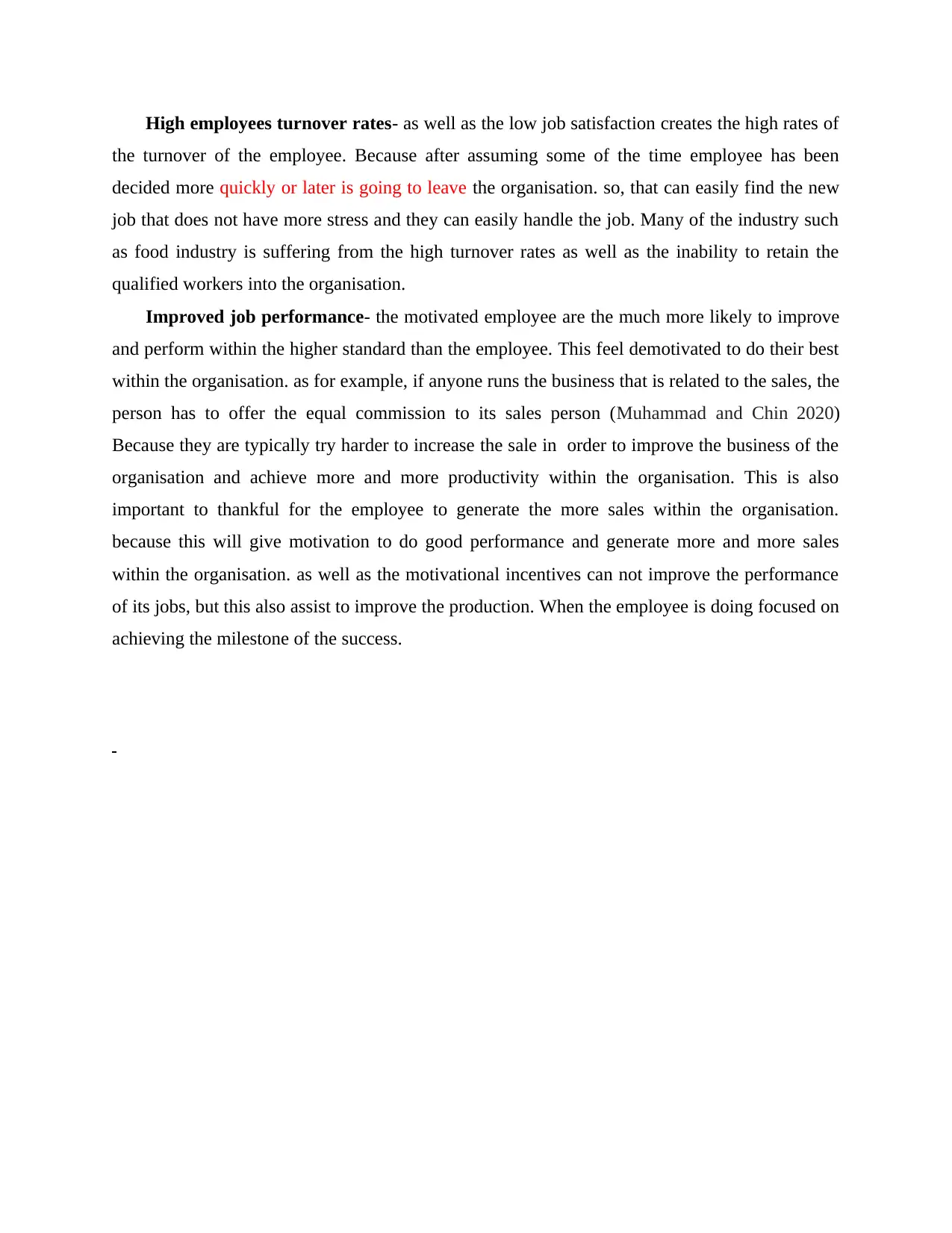
High employees turnover rates- as well as the low job satisfaction creates the high rates of
the turnover of the employee. Because after assuming some of the time employee has been
decided more quickly or later is going to leave the organisation. so, that can easily find the new
job that does not have more stress and they can easily handle the job. Many of the industry such
as food industry is suffering from the high turnover rates as well as the inability to retain the
qualified workers into the organisation.
Improved job performance- the motivated employee are the much more likely to improve
and perform within the higher standard than the employee. This feel demotivated to do their best
within the organisation. as for example, if anyone runs the business that is related to the sales, the
person has to offer the equal commission to its sales person (Muhammad and Chin 2020)
Because they are typically try harder to increase the sale in order to improve the business of the
organisation and achieve more and more productivity within the organisation. This is also
important to thankful for the employee to generate the more sales within the organisation.
because this will give motivation to do good performance and generate more and more sales
within the organisation. as well as the motivational incentives can not improve the performance
of its jobs, but this also assist to improve the production. When the employee is doing focused on
achieving the milestone of the success.
the turnover of the employee. Because after assuming some of the time employee has been
decided more quickly or later is going to leave the organisation. so, that can easily find the new
job that does not have more stress and they can easily handle the job. Many of the industry such
as food industry is suffering from the high turnover rates as well as the inability to retain the
qualified workers into the organisation.
Improved job performance- the motivated employee are the much more likely to improve
and perform within the higher standard than the employee. This feel demotivated to do their best
within the organisation. as for example, if anyone runs the business that is related to the sales, the
person has to offer the equal commission to its sales person (Muhammad and Chin 2020)
Because they are typically try harder to increase the sale in order to improve the business of the
organisation and achieve more and more productivity within the organisation. This is also
important to thankful for the employee to generate the more sales within the organisation.
because this will give motivation to do good performance and generate more and more sales
within the organisation. as well as the motivational incentives can not improve the performance
of its jobs, but this also assist to improve the production. When the employee is doing focused on
achieving the milestone of the success.
⊘ This is a preview!⊘
Do you want full access?
Subscribe today to unlock all pages.

Trusted by 1+ million students worldwide
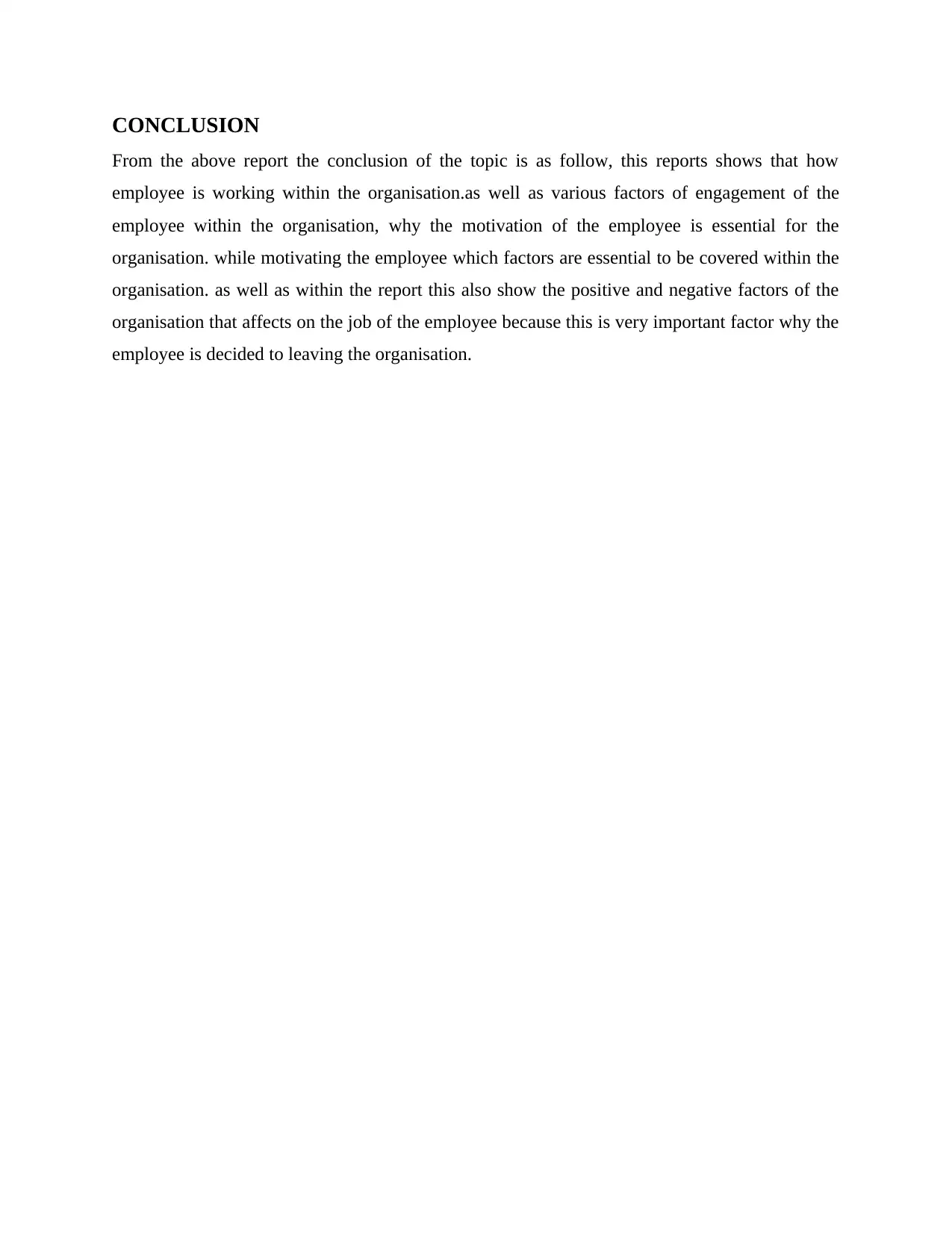
CONCLUSION
From the above report the conclusion of the topic is as follow, this reports shows that how
employee is working within the organisation.as well as various factors of engagement of the
employee within the organisation, why the motivation of the employee is essential for the
organisation. while motivating the employee which factors are essential to be covered within the
organisation. as well as within the report this also show the positive and negative factors of the
organisation that affects on the job of the employee because this is very important factor why the
employee is decided to leaving the organisation.
From the above report the conclusion of the topic is as follow, this reports shows that how
employee is working within the organisation.as well as various factors of engagement of the
employee within the organisation, why the motivation of the employee is essential for the
organisation. while motivating the employee which factors are essential to be covered within the
organisation. as well as within the report this also show the positive and negative factors of the
organisation that affects on the job of the employee because this is very important factor why the
employee is decided to leaving the organisation.
Paraphrase This Document
Need a fresh take? Get an instant paraphrase of this document with our AI Paraphraser
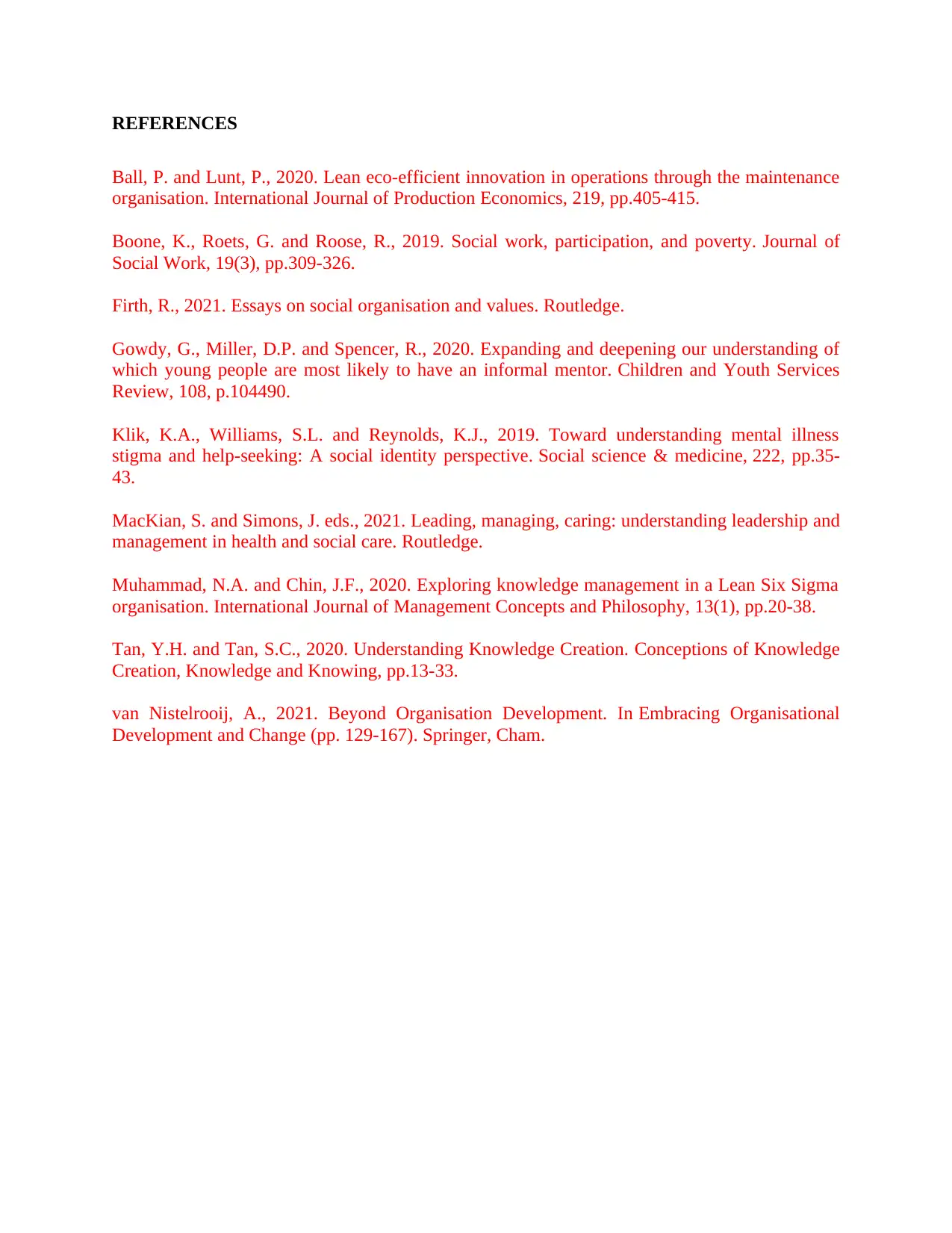
REFERENCES
Ball, P. and Lunt, P., 2020. Lean eco-efficient innovation in operations through the maintenance
organisation. International Journal of Production Economics, 219, pp.405-415.
Boone, K., Roets, G. and Roose, R., 2019. Social work, participation, and poverty. Journal of
Social Work, 19(3), pp.309-326.
Firth, R., 2021. Essays on social organisation and values. Routledge.
Gowdy, G., Miller, D.P. and Spencer, R., 2020. Expanding and deepening our understanding of
which young people are most likely to have an informal mentor. Children and Youth Services
Review, 108, p.104490.
Klik, K.A., Williams, S.L. and Reynolds, K.J., 2019. Toward understanding mental illness
stigma and help-seeking: A social identity perspective. Social science & medicine, 222, pp.35-
43.
MacKian, S. and Simons, J. eds., 2021. Leading, managing, caring: understanding leadership and
management in health and social care. Routledge.
Muhammad, N.A. and Chin, J.F., 2020. Exploring knowledge management in a Lean Six Sigma
organisation. International Journal of Management Concepts and Philosophy, 13(1), pp.20-38.
Tan, Y.H. and Tan, S.C., 2020. Understanding Knowledge Creation. Conceptions of Knowledge
Creation, Knowledge and Knowing, pp.13-33.
van Nistelrooij, A., 2021. Beyond Organisation Development. In Embracing Organisational
Development and Change (pp. 129-167). Springer, Cham.
Ball, P. and Lunt, P., 2020. Lean eco-efficient innovation in operations through the maintenance
organisation. International Journal of Production Economics, 219, pp.405-415.
Boone, K., Roets, G. and Roose, R., 2019. Social work, participation, and poverty. Journal of
Social Work, 19(3), pp.309-326.
Firth, R., 2021. Essays on social organisation and values. Routledge.
Gowdy, G., Miller, D.P. and Spencer, R., 2020. Expanding and deepening our understanding of
which young people are most likely to have an informal mentor. Children and Youth Services
Review, 108, p.104490.
Klik, K.A., Williams, S.L. and Reynolds, K.J., 2019. Toward understanding mental illness
stigma and help-seeking: A social identity perspective. Social science & medicine, 222, pp.35-
43.
MacKian, S. and Simons, J. eds., 2021. Leading, managing, caring: understanding leadership and
management in health and social care. Routledge.
Muhammad, N.A. and Chin, J.F., 2020. Exploring knowledge management in a Lean Six Sigma
organisation. International Journal of Management Concepts and Philosophy, 13(1), pp.20-38.
Tan, Y.H. and Tan, S.C., 2020. Understanding Knowledge Creation. Conceptions of Knowledge
Creation, Knowledge and Knowing, pp.13-33.
van Nistelrooij, A., 2021. Beyond Organisation Development. In Embracing Organisational
Development and Change (pp. 129-167). Springer, Cham.
1 out of 8
Related Documents
Your All-in-One AI-Powered Toolkit for Academic Success.
+13062052269
info@desklib.com
Available 24*7 on WhatsApp / Email
![[object Object]](/_next/static/media/star-bottom.7253800d.svg)
Unlock your academic potential
Copyright © 2020–2025 A2Z Services. All Rights Reserved. Developed and managed by ZUCOL.



